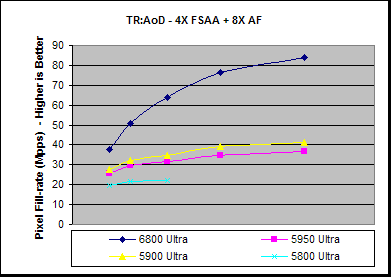Tomb Raider: Angel of Darkness
Tomb Raider: Angel of Darkness is currently still one of the few titles to utilise much DirectX9 functionality in the game. Here we'll be using our own internal benchmark demo.
| TR:AoD (FPS) |
640x480 |
800x600 |
1024x768 |
1280x960 |
1600x1200 |
| 6800 Ultra |
133.3 |
130.6 |
108.8 |
87.6 |
65.0 |
| 5950 Ultra |
105.8 |
82.9 |
53.9 |
38.5 |
25.8 |
| 5900 Ultra |
115.8 |
92.9 |
61.3 |
45.6 |
30.7 |
| 5800 Ultra |
85.6 |
62.1 |
39.7 |
27.5 |
15.1 |
| 6800 Ultra % Difference |
640x480 |
800x600 |
1024x768 |
1280x960 |
1600x1200 |
| 5950 Ultra |
26.0% |
57.6% |
101.9% |
127.3% |
151.9% |
| 5900 Ultra |
15.1% |
40.6% |
77.3% |
92.0% |
112.0% |
| 5800 Ultra |
55.8% |
110.4% |
173.7% |
218.1% |
331.9% |
The performance difference between the 6800 Ultra and the 5950 somewhat mirrors some of the Pixel Shader tests we looked at before, with the 5950 being very fill-rate (Pixel Shader) bound, even at fairly low resolutions, but the 6800 being much more capable and using its shader architecture to good effect in this game environment. Although the 6800 Ultra does get increasingly more fill-rate limited as the resolution increases, it doesn't appear that it is entirely so even at 1600x1200, and by this high resolution it has nearly 3 times the performance advantage over the 5950.
| TR:AoD - 4X FSAA + 8X AF (FPS) |
640x480 |
800x600 |
1024x768 |
1280x960 |
1600x1200 |
| 6800 Ultra |
122.4 |
105.9 |
81.1 |
62.3 |
43.8 |
| 5950 Ultra |
84.1 |
61.8 |
40.2 |
28.4 |
19.0 |
| 5900 Ultra |
90.1 |
66.8 |
43.9 |
31.9 |
21.4 |
| 5800 Ultra |
63.7 |
44.9 |
27.9 |
|
|
| 6800 Ultra % Difference |
640x480 |
800x600 |
1024x768 |
1280x960 |
1600x1200 |
| 5950 Ultra |
45.5% |
71.2% |
101.7% |
119.6% |
130.2% |
| 5900 Ultra |
35.8% |
58.4% |
84.8% |
95.6% |
104.7% |
| 5800 Ultra |
92.2% |
135.9% |
190.2% |
|
|
In comparison to normal rendering, the performance difference between the 6800 Ultra and the 5950 is higher at lower resolutions and lower at high resolutions with 4X FSAA and 8X AF enabled. The slight lowering of performance difference at high resolution is likely due to the increased bandwidth requirements of FSAA, though the large performance disparity between the two, with relatively low bandwidth differences, suggests that the colour compression with 6800 Ultra is working more effectively than 5950.
| 6800 Ultra (FPS) |
640x480 |
800x600 |
1024x768 |
1280x960 |
1600x1200 |
| Normal |
133.3 |
130.6 |
108.8 |
87.6 |
65.0 |
| 8X AF |
133.3 |
127.7 |
104.7 |
84.3 |
61.8 |
| 4X FSAA |
125.5 |
110.3 |
84.6 |
64.9 |
45.8 |
| 4X FSAA + 8X AF |
122.4 |
105.9 |
81.1 |
62.3 |
43.8 |
| % Diff from Normal |
640x480 |
800x600 |
1024x768 |
1280x960 |
1600x1200 |
| 8X AF |
0.0% |
-2.3% |
-3.7% |
-3.8% |
-5.0% |
| 4X FSAA |
-5.9% |
-15.6% |
-22.3% |
-25.9% |
-29.5% |
| 4X FSAA + 8X AF |
-8.2% |
-19.0% |
-25.4% |
-28.9% |
-32.6% |
Looking at the the performances of the 6800 Ultra under the various rendering modes we see that the performance under normal rendering is high, with a performance grater than 60 FPS even at 1600x1200. Applying 8X AF doesn't incur that much of a performance hit, at worst 5%, probably because this will be fairly bandwidth and occasionally shader limited, and the average performance is again over 60 FPS at 1600x1200. Enabling 4X FSAA takes a greater performance hit, again suggesting that there are bandwidth limitations, but the performance with both straight AA and with 8X AF enabled as well is still above 60 FPS at 1280x960. |
|



